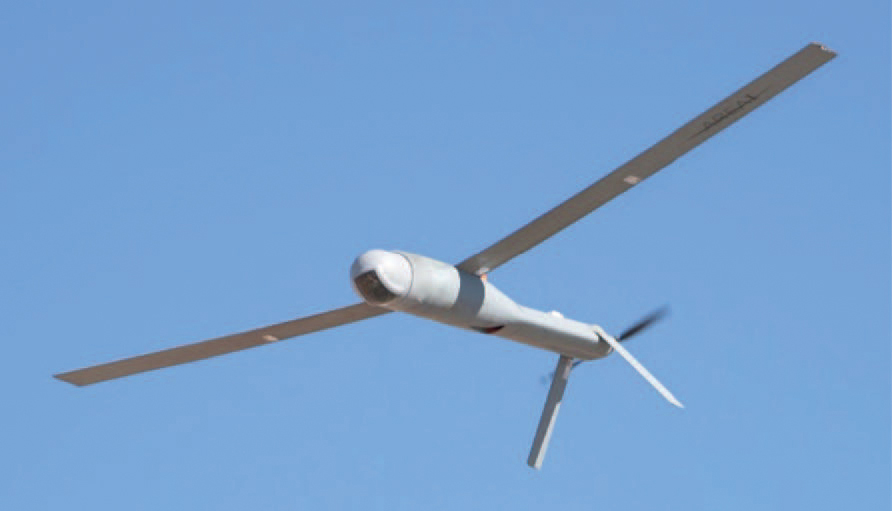TACTICAL OFFBOARD SENSING (TOBS)

Photo Courtesy of Lorelei White.
OVERVIEW
TOBS is a Small Unmanned Aircraft System (SUAS) launched from a host platform to enhance under-the-weather and standoff operations. Through an Advanced Technology Demonstration (ATD), TOBS is transitioning to the AC-130J Ghostrider, and there is increasing interest in this capability for other Air Force and Department of Defense platforms as the capability matures.
HOST PLATFORM INTEGRATION
TOBS builds on previous efforts – FINDER, Cutlass, and Coyote SUAS among others – that demonstrated the operational utility of air-launched SUAS while addressing key integration issues preventing previous transitions. In previous efforts, a dedicated SUAS operator and custom control station were required, and information could not flow machine-to-machine from the SUAS to the host platform.
TOBS addresses this by integrating the SUAS into the host platform’s systems in a nearly seamless manner. On the host platform, TOBS appears as just another sensor and is controlled just like already existing sensors. Although it is not possible to completely eliminate all SUAS flight management for safety reasons, regular interaction with TOBS is as a sensor, not as a SUAS.
FLEXIBILITY & GROWTH-CAPABILITY
TOBS command-and-control technology acts as an intermediary between the host platform and SUAS. The government provides an interface and waveform specification to be implemented on the SUAS by the manufacturer ensuring all SUAS are controlled in an agnostic manner. The SUAS interface also allows new SUAS and payload capabilities to be incorporated relatively quickly for flexibility and growth-capability.
REDEFINING THE STATE-OF-THE-ART

ALTIUS SUAS manufactured by Area-I.
TOBS is redefining the state-of-the-art for what is possible from a SUAS – 3x endurance, 2x radio range, air-launched at 200mph, and providing high quality video and very accurate geolocation of objects – and fitting all of that capability into a Common Launch Tube (48in long by 6in diameter) and being cheap enough to throw away.
The ALTIUS SUAS, developed by Area-I in Kennesaw, GA, under a Small Business Innovative Research effort, is a groundbreaking design that meets these demanding requirements. There are no exotic technologies or materials used in the design. Area-I has achieved mission endurance goals by paying close attention to all aspects of the design resulting in reduced weight and exceptional aerodynamics and propulsive efficiency while conforming to extreme size, shape, and launch requirements.
Radios were also a significant challenge and remain so. Imagine sending full motion video at least twice as far as has ever been done before within these size, weight, and power constraints, through weather, and between two maneuvering platforms. At the start of the effort, there were no suitable SUAS radios that could do this without negatively impacting other requirements, such as endurance. TOBS took advantage of emerging SUAS radio technology with both better hardware – lower size, weight, and power and better sensitivity – and new waveforms. Radios and antennas were carefully integrated, resulting in unprecedented range while still passing usable video.
Accurate geolocation of objects on the ground has also proved a significant challenge for SUAS in this size class. This is another area where TOBS is applying cutting edge technology to a real Air Force problem. In the last few years, very small (5 inch) imaging gimbal technology has improved greatly through advances in inertial measurement and pointing accuracy. TOBS has demonstrated direct geolocation accuracies approaching the level that previously required post-processing of the video to produce accurate coordinates. Through AFRL investment, small companies are producing highly accurate geolocation capabilities using relatively inexpensive inertial sensing and GPS components.
TO THE FUTURE
The basic TOBS architecture has matured rapidly allowing AFRL and operators to explore concept-of-employment, tactics, techniques, and procedures, human-machine interfaces, and automation for gunship applications. AFRL continues to address ongoing radio and gimbal performance challenges for the Gunship and other applications.
There are significant improvements in radio range beyond the significant improvements already achieved if a modicum of engineering effort is applied. These additional improvements would enable new CONOPS for Gunships and other platforms.
AFRL also continues to address the geolocation challenges from SUAS concentrating on real-time capabilities and low cost components. TOBS challenges industry to find ways to build low-cost sensor components for expendible aircraft while delivering the quality and consistency needed for mission success. These opposing constraints have spurred industry to examine manufacturing and materials processes and expand the use of interchangeable components in families of systems.
TOBS capabilities are already in motion for at least one other Air Force platform, and other Department of Defense components are engaged in similar efforts. Significant integrated offboard sensing capabilities are just a few years away.
